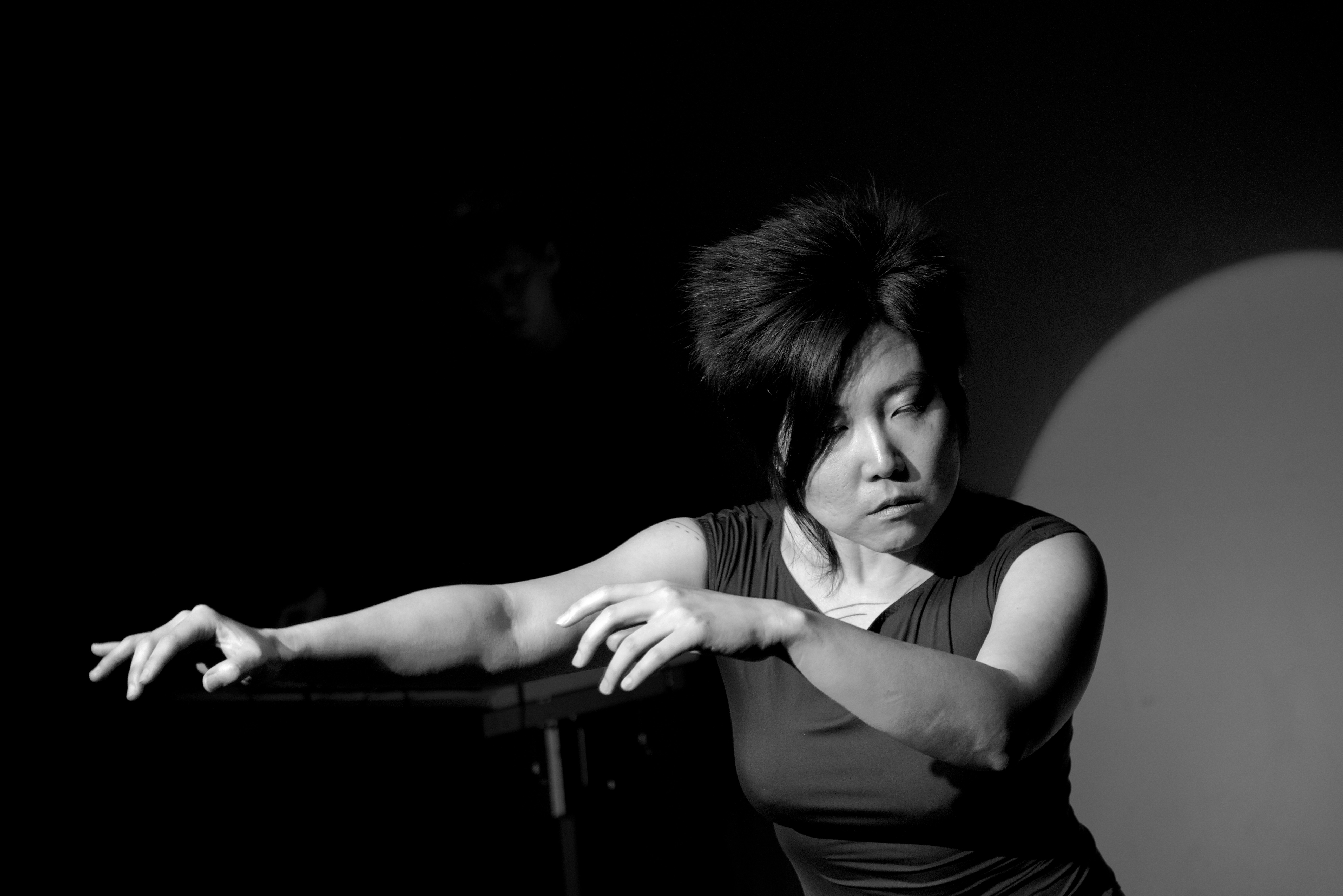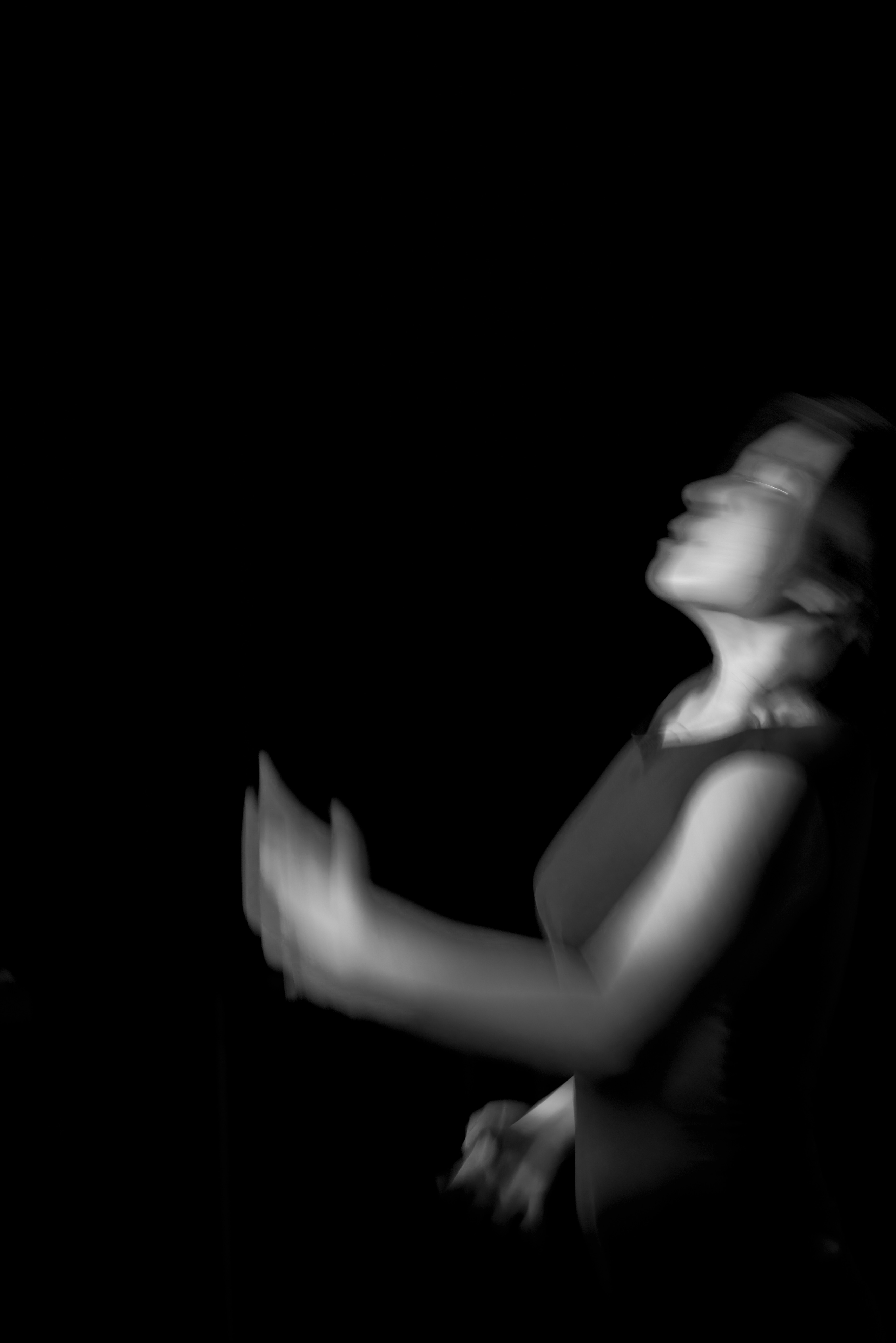Min Yoon is a post/butoh dancer and vocalist.
Their work exists within contemporary performance and experimental dance contexts, dreaming of transgressions on and off the stage.artist statement
With post/butoh dance, vocals, and philosophy, Min Yoon makes intimate, surreal, and psychophysical performances and experimental moments of heightened complex / relational emotions. Min’s dance collages intense imagery, physicality, stillness, and ritual. Min researches unintentional / subconscious movements with impulsive improvisation - to explore difficult truths beyond language and inherited social knowledge.
Min describes their method as Butoh / post/butoh / Butoh, expanding butoh dance with social questions, conflict studies, and embodied inquiries. Min dances with the question of whether butoh dance is mimicking patterns of oppression, and… what is the dance needed today.
“Not for the attention-seeking economy”, Min’s butoh+ experimental dance and vocal works process what feels more subconscious /unknown in being human such as around pain and violence, to grieve, reveal nuanced truths around the depths of emotions, experiences, and perspectives, and look for new expressions. Recent works switch between researching violence with their own body and the bodies of others. Their current solo work dancing-being-in-time depicts loops of movements, vocal tremors, and memories, with the body as an archive of pain, states, and transformation. In dancing with violence, they researched the bodily memories of violence of another dancer to create an auditory theater piece that invites listeners into poetic, sensory engagement with the material. In choreographic experiments, they question what are the images, imaginations, and group archetypes we need for our times, how bodies respond and move together unintentionally in groups, and how we may find instinctual ways to move together beyond how our bodies were trained.
In Germany, Min danced at Dock11, Hošek Contemporary Gallery, Oyoun, ZK/U, Tatwerk, Petersburg Arts Space, Trauma Bar und Kino (in residency), Kühlspot Social Club, p7 Gallery, Haus der Statistik, and 4fürtanz (leipzig). In the U.S. Min danced at CounterPulse (sf), Headwaters Theater (pdx), ProArts Gallery (sf), Highways Performance Space (la), Epic Immersive (sf). Min also dances in the streets, nature, and many underground community spaces as well as in churches and a temple devoted to Minerva in Italy.
Min’s performances and social artworks have been funded by NATIONALES PERFORMANCE NETZ (npn) in Germany, Dachverband Tanz Deutschland, Kultuuri Kaupilla in Finland, The City of Oakland, The Battery Club of San Francisco, and the Awesome Foundation, with other artist residencies and grants. Min has also been a fellow at Zentrum für Kunst und Urbanistik (ZK/U Berlin) and an artcorps scholar at the Tamalpa Institute founded by Daria and Anna Halprin.
Min has been a part of international collaborations with artists Ari David, Nicola Bullock, Jessica Gaynor, Rodrigo Zorzanelli, ingo reulecke, hen/i,
and musicians, Wieland Möller, Korhan Erel, Nicolas Wiese, Nick Dunston, Francis Heery, Edith Steyer, Samuel Hall, Germán Gabriel Garcia, Phillip Greenlief, Kevin Corcoran, Roman Stolyar, Klaus Janek, Tom Foskett-Barnes, CYANE, Crystal Quartez, and more.
Min has performed in the works of Atsushi Takenouchi (Italy), Joana Von Mayer Trindade (Portugal), Anastazia Louise Aranaga (USA), Mizu Desierto (USA), Estrellx Supernova (USA), Ariellah Aflalo (USA), Kudo Taketeru (Japan), Slava Inozemecev (Belarus), and pussy riot.
___
bio / a chronological story and tribute to lineage
I started attempting to create meaning in a secular age by studying existential philosophy and conceptual art through the Rhetoric and Philosophy BA at U.C. Berkeley, then looked for ways to bring these philosophies alive in narrative theater and social games. I went on to discover the power of what is unspoken, yet felt through the body, in what felt like the deepest experience of connection with butoh dance - a style of revolutionary art form created in WWII era that expresses aesthetics of life and death. Since discovering butoh dance, I have been working to bring together different art forms in intimate, theatrical, and embodied experiences and artistic rituals.
I had the chance to intensively study, perform, and live in artistic residency with master butoh teachers Atsushi Takenouchi of Jinen Butoh School in Italy, Anastazia Louise of Bad Unkl Sista, and Mizu Desierto of Water in the Desert at their permabutoh farm, as well as continuous training in choreography and dance with master teachers in San Francisco and Berlin. I have also undergone the Life/Art Process and training as an ArtCorps scholar at the Tamalpa Institute by Anna and Daria Halprin and am a registered movement educator and facilitator with ISMETA.
My artistic questioning and life found some turns when some conflict facilitators came to the “Origins of a Woman” show on the history of comfort women, and Gary Reiss, who works with world issues and spiritual studies, invited me to study conflict with butoh dance at the Process Work Institute with a scholarship. This was around the time George Floyd was murdered and the racial and social divides were louder and I needed to confront what is happening off the stage. I recently completed the MA in Process Oriented Psychology and Conflict Studies, and researched how the body communicates emotions that are less conscious to the intelligible parts of us.
My experiences also include experimenting with group rituals as part of an interfaith wellness center with my philosophy teacher, Tyler Krupp, and producing residencies and shows as part of the legendary CounterPulse theater in SF.
“They say it’s the last song.
They don’t know us, you see.
It’s only the last song if we let it be.”
- Dancer in the Dark

Min Yoon © Thuong Dang

